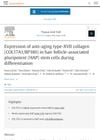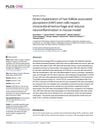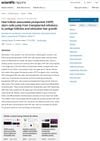 29 citations
,
March 2016 in “Cell cycle/Cell cycle (Georgetown, Tex. Online)”
29 citations
,
March 2016 in “Cell cycle/Cell cycle (Georgetown, Tex. Online)” Isoproterenol helps hair follicle stem cells turn into beating heart muscle cells.
64 citations
,
May 2015 in “Cell Cycle” The study demonstrated that hair-follicle-associated pluripotent (HAP) stem cells, which express the neural stem-cell marker nestin, could differentiate into beating cardiac muscle cells. These stem cells, derived from both mouse and human hair follicles, were previously shown to differentiate into various cell types, including neurons and smooth muscle cells. In this study, the researchers found that all parts of the mouse vibrissa hair follicle could differentiate into cardiac muscle cells, with the upper part showing the greatest potential. The cardiac muscle cells' beat rate was influenced by isoproterenol and propanolol. This finding suggested that HAP stem cells could be used in regenerative medicine for heart disease, as well as for nerve and spinal cord repair.
32 citations
,
January 2014 in “Cells tissues organs” Hair follicle stem cells can help repair nerve and spinal cord injuries.
47 citations
,
August 2012 in “Cell Cycle” The study demonstrated that multipotent, nestin-expressing stem cells were present throughout the vibrissa hair follicle, with the greatest differentiation potential in the upper part. These stem cells, identified using a transgenic mouse model, could differentiate into neurons, glia, keratinocytes, smooth muscle cells, and melanocytes. The upper part of the follicle produced a large number of spheres from nestin-expressing cells, which differentiated into various cell types, suggesting potential applications for nerve and spinal cord repair.
121 citations
,
June 2009 in “Journal of Cellular Biochemistry” 144 citations
,
June 2008 in “Cell Cycle” The study demonstrated that multipotent hair follicle stem cells from C57BL transgenic mice could promote the repair of spinal cord injuries and aid in the recovery of walking function. These stem cells, which were positive for stem cell markers nestin and CD34, but negative for keratin 15, were capable of differentiating into various cell types, including neurons and Schwann cells. When transplanted into the injury site of severed thoracic spinal cords in mice, the cells primarily differentiated into Schwann cells, facilitating the repair and reestablishment of hind-limb locomotor performance. The findings suggested that hair follicle stem cells could serve as an effective, accessible source for treating peripheral nerve and spinal cord injuries.
319 citations
,
November 2005 in “Proceedings of the National Academy of Sciences” 419 citations
,
March 2005 in “Proceedings of the National Academy of Sciences” 212 citations
,
August 2004 in “Proceedings of the National Academy of Sciences” Hair follicle cells can create new blood vessels in the skin.
352 citations
,
August 2003 in “Proceedings of the National Academy of Sciences”



